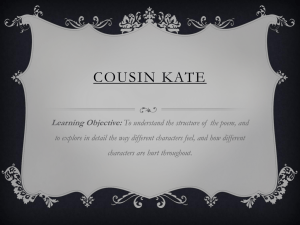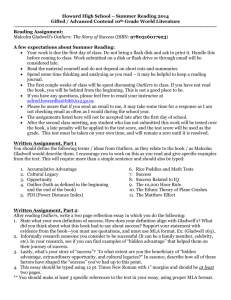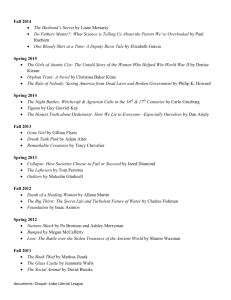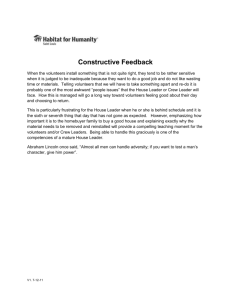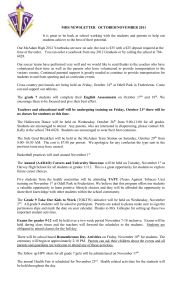Freedom Summer - Consequential Strangers
advertisement
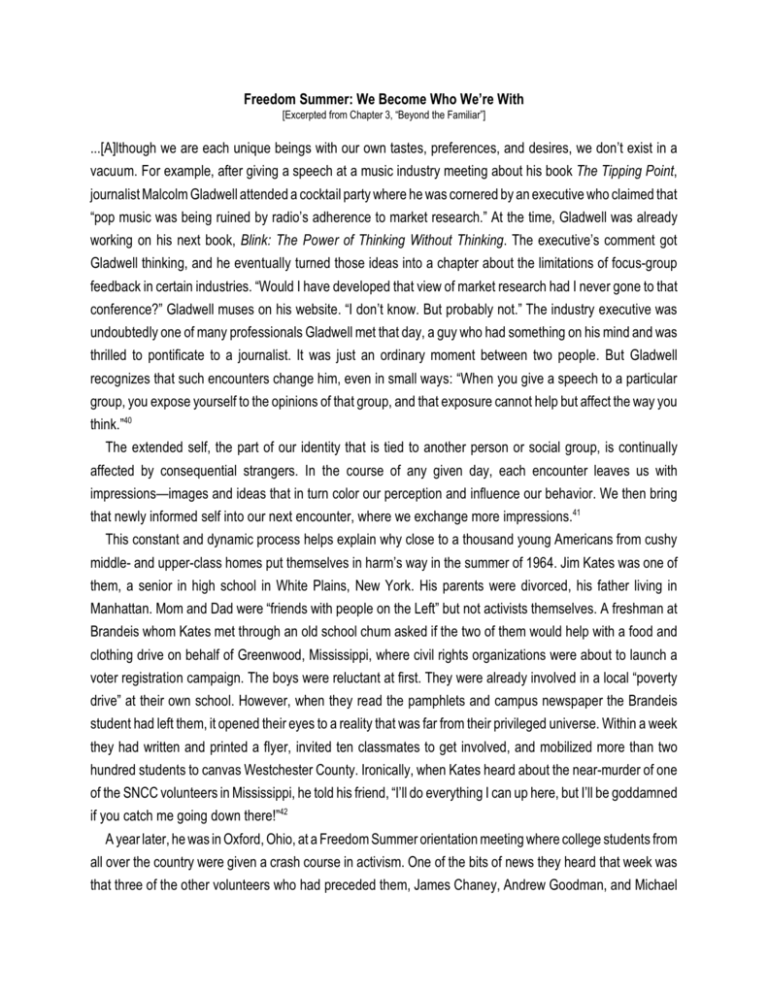
Freedom Summer: We Become Who We’re With [Excerpted from Chapter 3, “Beyond the Familiar”] ...[A]lthough we are each unique beings with our own tastes, preferences, and desires, we don’t exist in a vacuum. For example, after giving a speech at a music industry meeting about his book The Tipping Point, journalist Malcolm Gladwell attended a cocktail party where he was cornered by an executive who claimed that “pop music was being ruined by radio’s adherence to market research.” At the time, Gladwell was already working on his next book, Blink: The Power of Thinking Without Thinking. The executive’s comment got Gladwell thinking, and he eventually turned those ideas into a chapter about the limitations of focus-group feedback in certain industries. “Would I have developed that view of market research had I never gone to that conference?” Gladwell muses on his website. “I don’t know. But probably not.” The industry executive was undoubtedly one of many professionals Gladwell met that day, a guy who had something on his mind and was thrilled to pontificate to a journalist. It was just an ordinary moment between two people. But Gladwell recognizes that such encounters change him, even in small ways: “When you give a speech to a particular group, you expose yourself to the opinions of that group, and that exposure cannot help but affect the way you think.”40 The extended self, the part of our identity that is tied to another person or social group, is continually affected by consequential strangers. In the course of any given day, each encounter leaves us with impressions—images and ideas that in turn color our perception and influence our behavior. We then bring that newly informed self into our next encounter, where we exchange more impressions.41 This constant and dynamic process helps explain why close to a thousand young Americans from cushy middle- and upper-class homes put themselves in harm’s way in the summer of 1964. Jim Kates was one of them, a senior in high school in White Plains, New York. His parents were divorced, his father living in Manhattan. Mom and Dad were “friends with people on the Left” but not activists themselves. A freshman at Brandeis whom Kates met through an old school chum asked if the two of them would help with a food and clothing drive on behalf of Greenwood, Mississippi, where civil rights organizations were about to launch a voter registration campaign. The boys were reluctant at first. They were already involved in a local “poverty drive” at their own school. However, when they read the pamphlets and campus newspaper the Brandeis student had left them, it opened their eyes to a reality that was far from their privileged universe. Within a week they had written and printed a flyer, invited ten classmates to get involved, and mobilized more than two hundred students to canvas Westchester County. Ironically, when Kates heard about the near-murder of one of the SNCC volunteers in Mississippi, he told his friend, “I’ll do everything I can up here, but I’ll be goddamned if you catch me going down there!”42 A year later, he was in Oxford, Ohio, at a Freedom Summer orientation meeting where college students from all over the country were given a crash course in activism. One of the bits of news they heard that week was that three of the other volunteers who had preceded them, James Chaney, Andrew Goodman, and Michael Schwerner, were missing. And although no one said so above a whisper at first, the three were presumed dead. This was their welcome to Mississippi, a state mortally committed to preserving the “Southern way of life” even as the rest of the region was grudgingly beginning to change. Since the early fifties, the NAACP and other predominantly black organizations had successfully challenged Jim Crow laws, resulting in the 1954 Supreme Court decision that declared segregation in public schools illegal. The success of bus boycotts, sitins, and freedom rides further buoyed the hopes of black activists, but change was slow, especially in Mississippi. Most white citizens there were as virulently opposed to integration as they were to modernization—for generations, the “planter elite” had relied on cheap agricultural labor. Mississippi had the lowest rates of high school completion and the highest rates of poverty, the lowest rates of black voter registration and the highest rates of lynching.43 Although white civil rights workers, led in large part by the Student Non-Violent Coordinating Committee, or SNCC (pronounced “snick”), knew the extent to which the most bigoted would go to thwart their efforts, the rest of the country was mostly unaware of the violence at that point. Freedom Summer, a project that lasted for a mere three months, would not only make visible the horrors of Mississippi, it would transform the consciousness of America and mark the true beginning of what we now think of as “the sixties.”44 What made Freedom Summer volunteers like Jim Kates willing to leave the comfort of home to risk their lives? Doug McAdam, a sociologist who has spent most of his career studying the link between social movements and networks, wanted to find out. Looking for a list of the participants so that he could interview them retrospectively, McAdam happened on a box of materials at the King Center in Atlanta. Inside were the original five-page questionnaires the 959 applicants had filled out prior to that eventful summer. He could barely still his researcher’s heart as he realized that before him were not only the responses of the 720 students who actually went to Mississippi that summer, but also those of the 239 no-shows—a natural control group. By comparing the two groups of applicants, McAdam might discover what set the no-shows apart from those who actually made it to the front lines. The applicants, who were of different religions and from all parts of the country, were indistinguishable in terms of attitude. Most had grown up as the protected, if not pampered, offspring of parents who had lived through the Depression and World War II and believed wholeheartedly in the postwar promises of America. Thanks to their prosperity, their children also had the time and money to get involved. Ninety percent of the applicants belonged to some type of organization—62% listed two or more. Nearly half (48%) were members of civil rights organizations, which meant that most already had a taste of what it meant to be part of something bigger. “Playing at being an activist,” McAdam explains, “is usually the first step in becoming one.”45 Their motives were a mixed bag, but youthful idealism was evident in their responses to questions on the applications. Contrary to popular belief, they did not enlist as an act of rebellion; most of their parents sympathized with the movement. Many mentioned the late President Kennedy’s call to “do” for their country. Being young, some were also in it for the adventure. Jim Kates, for one, finally decided to go because his original summer plans—to work in a theater in Nantucket—fell through. Gung-ho as they all might have been when they applied in February or March, waiting until June gave them ample opportunity to have second thoughts. Beatings and burnings, even murder, were commonplace in Mississippi, but now the violence was escalating, largely in anticipation of the “army from the North.” The news was enough to convince some to watch from the sidelines. Others, especially women and applicants under twenty-one, were held back by apprehensive parents who refused to sign permission forms. But the single factor that distinguished the participants from the no-shows, McAdam found, was “social proximity.” When they were asked to name ten or more people who “would be interested in receiving information about your [summer] activities,” around a quarter of all applicants listed other project participants. But the volunteers listed more than twice as many as the no-shows. Backing out meant disappointing, or risking the disapproval of, people they knew.46 Volunteers also belonged to more organizations than the noshows, particularly civil rights groups, and they were more deeply immersed in the cause. This not only gave them the opportunity to “play” the activist role, it put them in groups of like-minded people. It’s impossible to discern from the applications whether these connections were best friends or casual acquaintances. However, as McAdam explains, “a movement can’t spread without the influence of weak, bridging ties.” This is certainly evident in interviews with Freedom Summer veterans. Asked what motivated them, most begin by talking about a person or group that piqued their awareness. Sometimes it was a close friend, sometimes not. The student from Brandeis who whetted Jim Kates’s appetite was a friend of a friend. Others were influenced by teachers or local organizers. And when they talk about their experiences in Mississippi, they speak mostly of the bonds they formed with volunteers from other parts of the country, townspeople and teachers they worked with, and families that housed them. For many, this was their first time living in a rural, impoverished setting, no less in the black community. Interacting with such a variety of people—by definition, consequential strangers—expanded their consciousness, gave them a different sense of themselves in the world. “I was on a project with forty people. You had friends, but mostly not,” offers Chude Allen, a self-described “goody-goody” from the Midwest, the daughter of God-fearing Eisenhower Republicans.47 That a young woman could be “sexually active and mellow about it,” for example, was something that had never occurred to Allen, who was “saving it for marriage,” as good girls then did. “It opened a door for me.” Volunteers always traveled in twos. They didn’t choose their partners; it depended on what they were assigned to do on a given day. Jim Kates recalls a time when he and Willie Curtis Johnson, a local high school boy, were returning from a voter registration drive. Seeing an ominous group of good ol’ boys ahead of them, Johnson, having learned early in life to dodge angry white men, crossed the street to avoid trouble. Kates, accustomed to white privilege, kept going until one of the men blocked his path: “Boy, you better be out of town by sunset if you don’t want to end up like those three.” Kates knew he meant Chaney, Goodman, and Schwerner. Only days before, he had written in his journal, “How the ghosts of those three shadow all our work!” Seeing the standoff, Johnson suddenly called out to Kates, beckoning him toward his stepfather’s barbershop across the street. Petrified, Kates turned his back on the three white men and started walking. He got lucky that day, thanks to the quick thinking of a young black man he hardly knew. Allen, Kates, and other volunteers say they were “forever changed” after that summer. They met people they would never have known, heard stories they would never have heard. As in the case of Doug Davis, the experience activated their extended selves. Psychologist Marilynn Brewer notes that when “the boundaries of the self are redrawn” in this more expansive way and particular roles are “activated” by being a member of a group or collective, those roles in turn become more important to us. We want to behave in a way that reflects well on the group.48 In all likelihood, Kates had the courage to turn his back on the men who threatened him, because at that moment he was not acting out of self-interest. He was on a mission. This also might explain why he and his fellow volunteers didn’t boast of their personal exploits when they returned to their respective campuses. “Other people recognized our experience, but we could not trade on it. We had been foot soldiers.” The cause was greater than any one of their individual selves. After they left Mississippi, Freedom Summer veterans insinuated themselves in the various other liberation movements that characterized the decade. Liberalism and social justice became central to their identities. Their lives were filled with consequential strangers who were very different from them (and from one another) but equally committed to changing the system. Asked to define their political leanings, with “1” indicating the far left and “10” the radical right, both groups of applicants started out in the 3.5 range. After the experience, however, nearly two-thirds felt they had moved “further to the left,” while the no-shows exhibited only a slight change. But a numerical comparison doesn’t begin to capture the true impact of Freedom Summer, says McAdam: “For it wasn’t anything as narrow as their attitudes that changed, as much as it was the way they saw and interpreted the world.” End Notes 40. Malcolm Gladwell, “Disclosure Statement,” website, http://gladwell .com/disclosure.html. 41. Florence Passy, “Social Networks Matter. But How?” in Social Movements and Networks: Relational Approaches to Collective Action, edited by Mario Diani and Doug McAdam (New York: Oxford University Press, 2003), 21–48. 42. Jim Kates, interview with Blau, February 12, 2008. Kates, “June 1964,” Veterans of the Civil Rights Movement website, http://crmvet.org/info/katesexp.htm. 43. Doug McAdam, Freedom Summer (New York: Oxford University Press, 1988). 44. Ibid. 45. Doug McAdam, interview with Blau, September 6, 2007. 46. McAdam, interview. 47. Chude Allen, interview with Blau, December 6, 2007. Jim Kates and another movement veteran, Jane H. Adams, also noted that when it came to activism, their casual acquaintances, not their best friends, were more likely to be involved. 48. Brewer and Gardner, “Who Is This ‘We’?: Levels of Collective Identity and Self Representations.”
